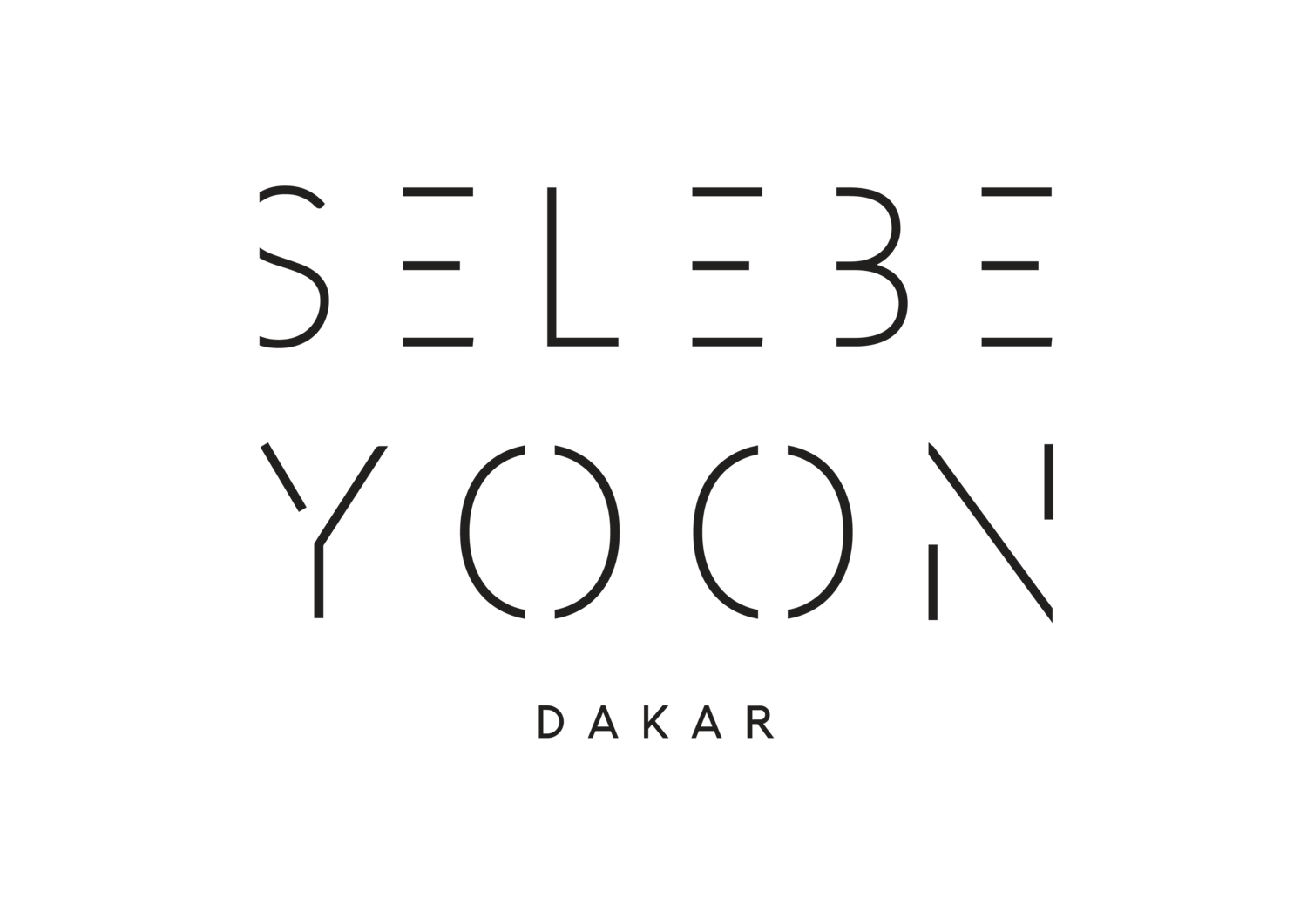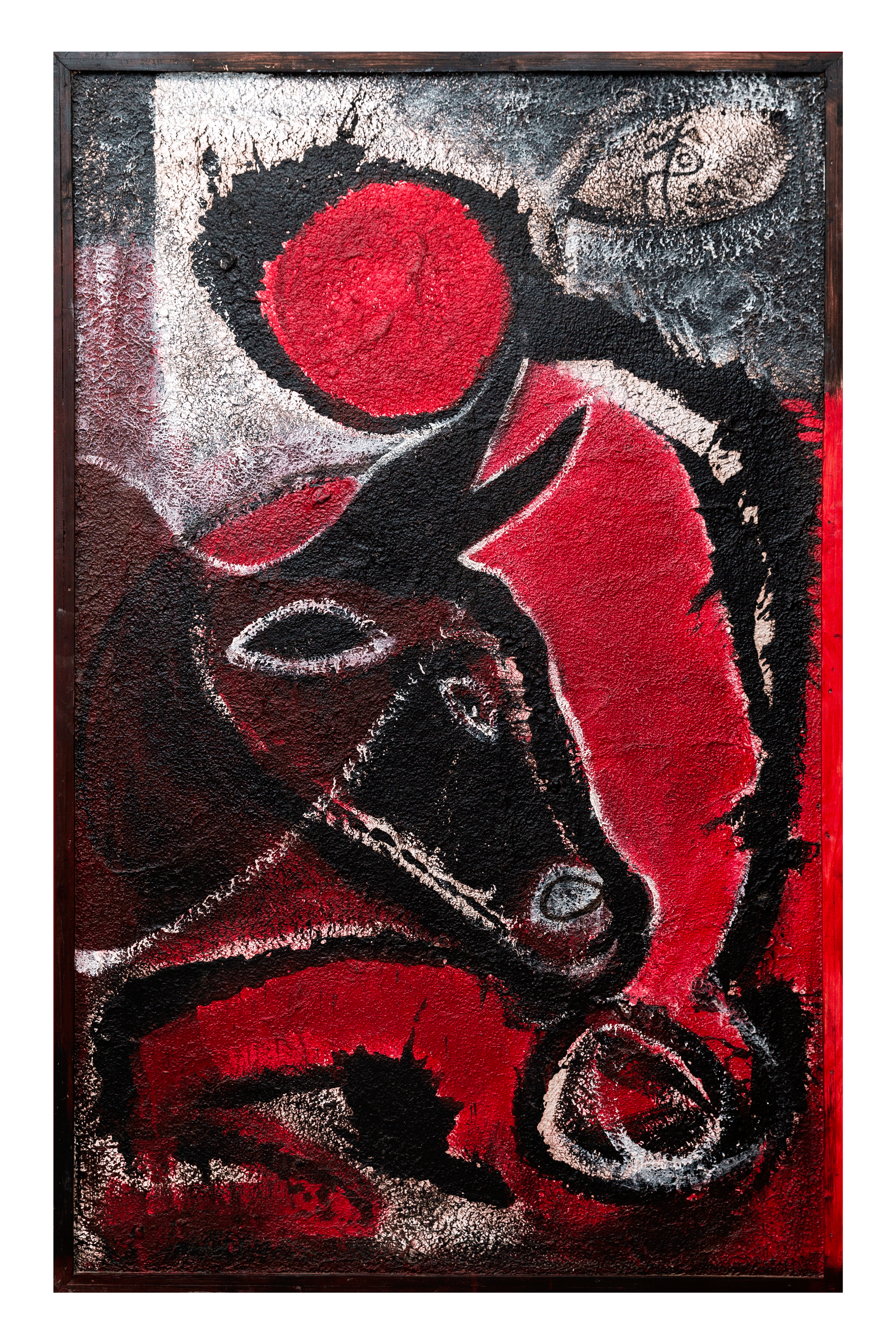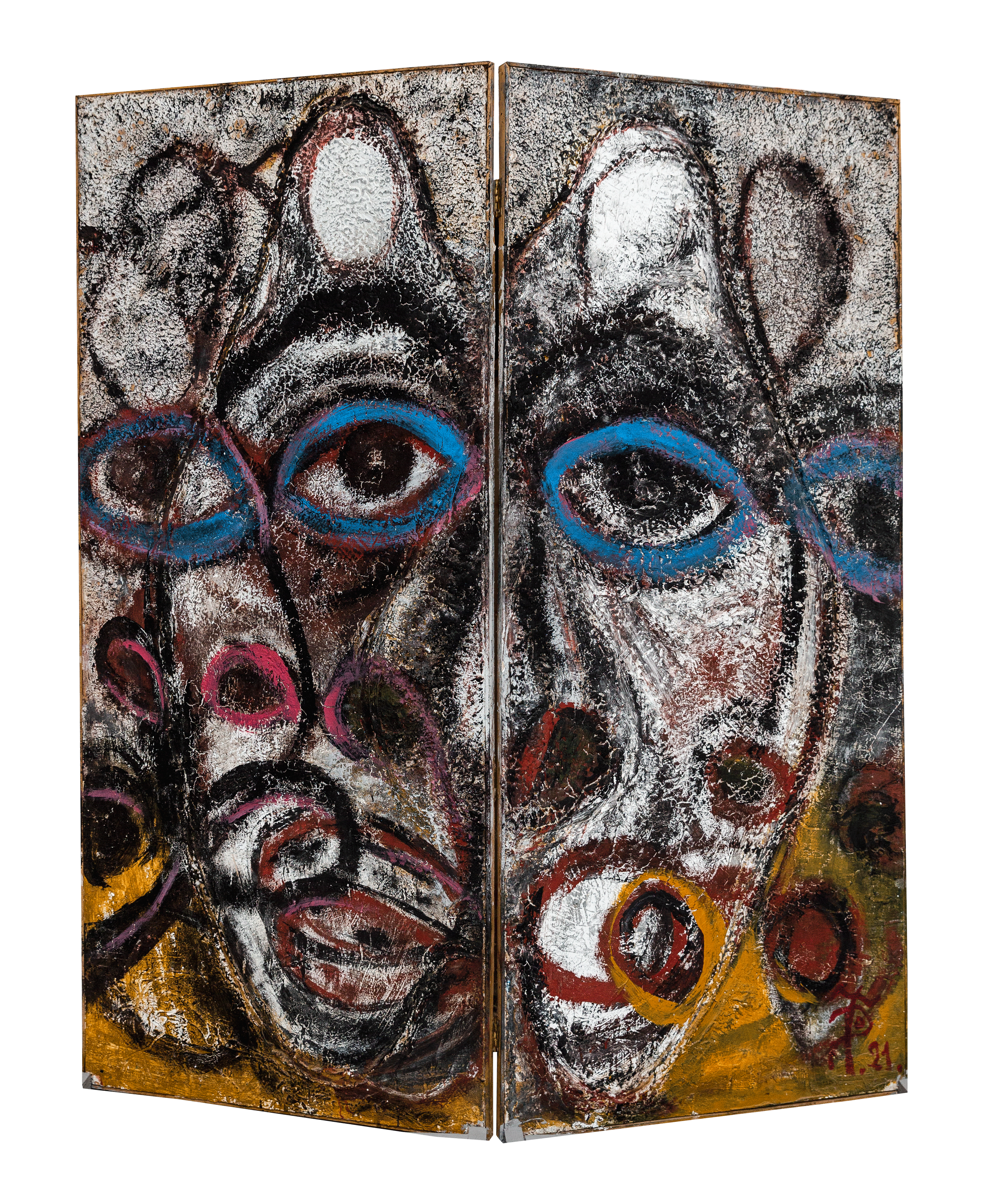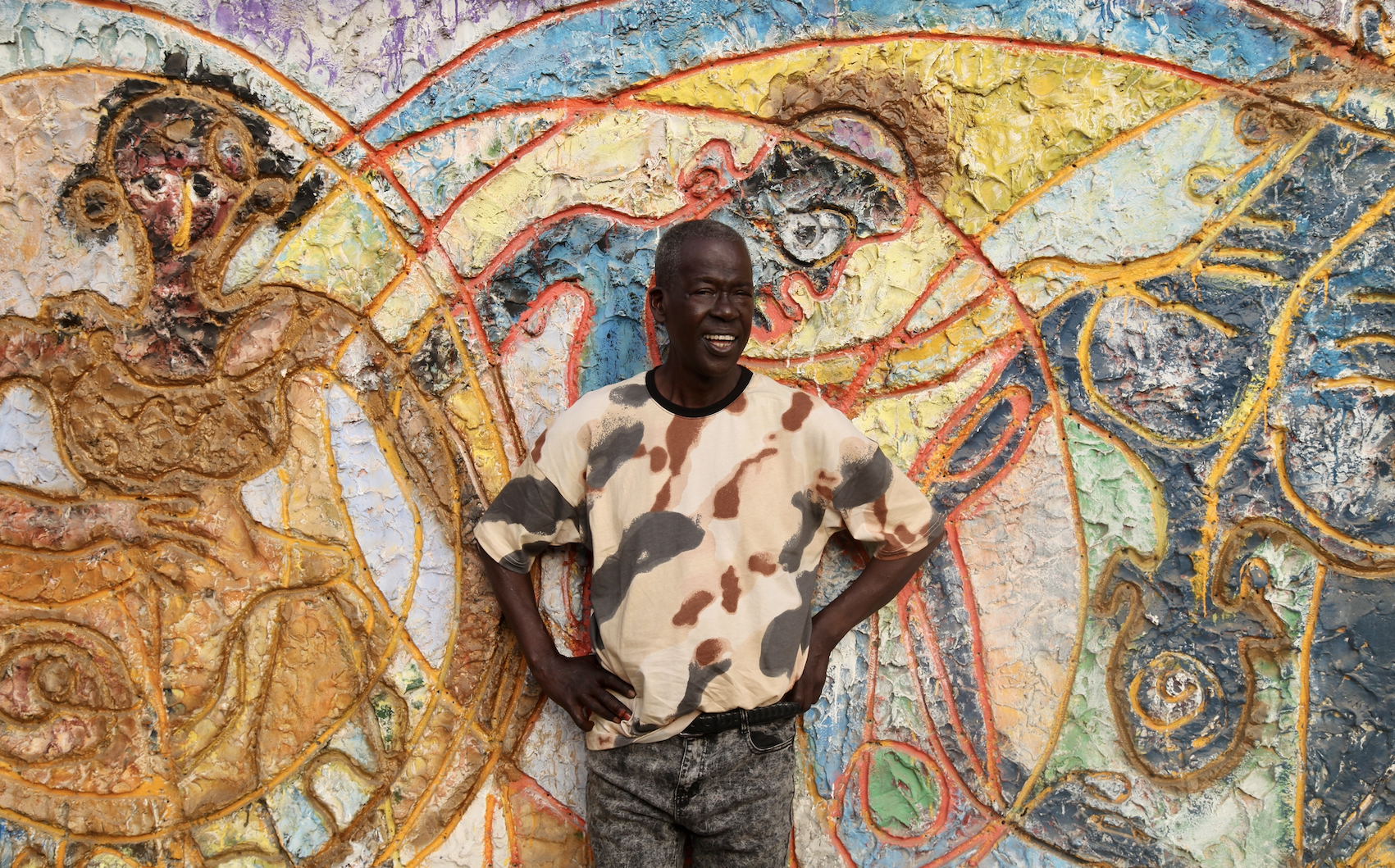El Hadji Sy
Exhibition: Now / Naaw at Selebe Yoon, Dakar 2022.
After more than fifty years of career, a witness to a colonised society intransition, an important voice in the development of a new modernity, the itinerary of El Hadji Sy is transnational, travelling and working across Western or African countries such as South Africa on the brink of apartheid. Yet his artistic life profoundly anchors itself in the city he chose not to ever leave, Dakar.
Upon graduating from the school of Beaux-Arts in 1977 in Dakar, he remained defiant towards state cultural policy and the aesthetics principles of the negritude - yet he received the support and admiration of former president Leopold Sedar Senghor with whom he exchanged and confronted with continuously. In the 1970s, he walked, stamped, danced and painted with his feet on the canvas as an act of rupture with the aesthetics of the Beaux-Arts. Outside institutional walls, he worked artistically in social spaces, such as streets, hospitals, and train stations in order to involve a wider public and merge his interests in education, development and art. As a painter, his works are made with a variety of materials such as industrial jute sacks originally used to ship rice or sugar, kites, butcher’s paper and recycled paper, mirrors, glass, shells, wood, tar - and all hold a performative function. Mobile like props on a stage, semi-functional, blurring the boundaries between functionality and aesthetics, his works metamorphose into paravents, doors, windows, clothes, furnitures and itinerant structures.
His political stand manifests itself with paintings both figurative and abstract that convey a visual musicality whereby the bodies and forms submit themselves to a permanent undulatory rhythm. His work can evoke aesthetic responses to historical events such as the 228 portraits of “Joola” (2003) in reference to the shipwreck on the coast of Senegal from 2002 or “Archéologie Marine” (2014) - a monumental piece presented at the Sao Paulo Biennale in echo to the slave trade. From poetic interpretations of political phenomenon, renderings of daily scenes, references to Dakar’s urbanism, portraits of political, intellectual, mythological or ordinary figures, his works interweave politico-socio economical comments and critical reflections on cultural and globalized systems of production. Influenced by the language of theatre, he orchestrates his exhibitions as a “mises-en-espace” (staging of space) and searches for performative modes of presentations in order to reconcile theatre, music, dance, literature and design.
El Hadji Sy disobeys the “don’t-touch” institutional rule of museums that sanctifies the artwork and imposes a distant and contemplative relationship to the visitor. In his exhibition, the artist-scenographer subverts the space, imposes a choreography to the visitor who must work around, touch, walk through, open or close the piece in order to have access.
Committed to developing autonomous infrastructures for artists based in Senegal, El Hadji Sy created studio complexes such as the first Village Des Arts from 1977-1983 from which the artists were eventually expelled, and a second one in 1996 in a former Chinese workers’ camp - the current Village Des Arts. While the controversial exhibition «Primitivism in the 20th Century » at MoMA opened its door in 1984, El Hadji Sy conceived that same year a contemporary Senegalese art collection for the Weltkulturen Museum in Frankfurt – a pioneering work that shortly after, resulted in the first anthology of Senegal’s contemporary visual art, prefaced by Leopold Sedar Senghor. Committed to write a non-western and modern history, he was invited by the curator Clementine Deliss as the co-curator of the exhibition “Seven Stories about Modern Art in Africa” at the Whitechapel Gallery in London in 1995 during Africa95.
In 2015, he received a major retrospective “Painting, Performance, Politics” curated by Clementine Deliss, Yvette Mutumba and Philippe Pirotte at the Weltkulturen Museum in 2015 where the artist placed his work in dialogue with objects from the museum’s ethnographic collection, thus offering a critical reflexion on museology. Throughout his career, he participated in collective initiatives such as the project space “Tenq” with which he organized international workshops in the 1990s as well as “Huit Facettes” - a group of artists that undertook creative projects in rural areas, then presented at Documenta 11 in Athens in 2002.
Throughout his career, he participated in collective initiatives such as the project space “Tenq” with which he organized international workshops in the 1990s as well as “Huit Facettes” - a group of artists that undertook creative projects in rural areas, then presented at Documenta 11 in Athens in 2002.
El Hadji Sy works and lives in Dakar.
Works
Biography
El Hadji Studio at his studio, Dakar, 2021
Copyright: Selebe Yoon
As a multidisciplinary artist, cultural activist, curator and art historian, El Hadji Sy (born in Dakar, 1954) is one of the pioneering artists of Senegal in the post-independence period and is one of the founders of Africa’s most important artist collective founded in 1974 - Le Laboratoire Agit’Art.
El Hadji Sy has always been involved in the development of art and culture of his country through collective initiatives. In 1977, he founded the first Village des Arts in a former military camp based in Dakar city center. Forced to close down, he then took over a Chinese camp and transformed it in artist studios, the current “Village des Arts”. Throughout these years, he organized international workshops with the project space and artist group “Tenq” as well as “Huit Facettes” a collective taking part in rural areas whose work was presented at Documenta 11 in 2002, In 1984,
He had several solo exhibitions such as: «Les Tambours de la Mer» presented at Selebe Yoon in Dakar, Senegal (2023); Galerie Barbara Thumm, Berlin, Germany (2022); Musée de la Rue, Dakar, Senegal (2020); U-jazdowski Castle Center for Contemporary Art, Warsaw (2016); “Glass Letters”, Bookoo Gallery, Dakar, Senegal & São Paulo Biennial (2013-2014); BrazilLinda Goodman Gallery, Johannesburg, (1995); Paul Waggoner Gallery in Chicago, USA and the Centre Culturel Français, Abidjan, Ivory Coast, Africa (1981)...
Internationally, his work has been exhibited in many institutions through several group exhibitions such as: “Carnivalesca, What Painting Might Be”, curated by Bettina Steinbrügge, Kunstverein Hamburg, Germany(2021); “New Images of Man”, curated by Alison M. Gingeras, Blum&Poe, Los Angeles, CA, USA(2020); “Disso - Concertation”, documenta 14, Kassel, Germany (2017); la National Gallery, Prague (2016); 31st São Paolo Biennale, São Paolo, Brazil (2015); “Art sénégalais d’aujourd’hui (Senegalese Art Today)“, Touring exhibition, Museum of Fine Arts, Boston, Boston, USA and Chicago Public Library, Chicago, USA (1980)...
The artist received a major retrospective painting, performance, politics curated by the artist together with Clémentine Deliss, Yvette Mutumba and Philippe Pirotte at the Weltkulturen Museum in 2015.
In 1984, he was invited to build a collection of contemporary art from Senegal for the Weltkulturen Museum, an ethnographic museum in Frankfurt, and on this occasion published the first anthology of the arts of Senegal, prefaced by Léopold Sédar Senghor in 1989. This research published one year before "Les Magiciens de la Terre" at the Centre Pompidou in Paris (1989) contextualizes contemporary art in Senegal and reveals a non-Western modernity.
His works are in a number of important collections: Weltkulturen Museum (Germany), the Blachère Foundation (France), David Bowie (USA), Bassam Chaitou/Jom Collection (Senegal), Kehinde Wiley (USA/Senegal), Jean Loup Pivin (France). Despite having travelled and exhibited internationally,
El Hadji Sy has always been working and living in Dakar, Senegal.



























